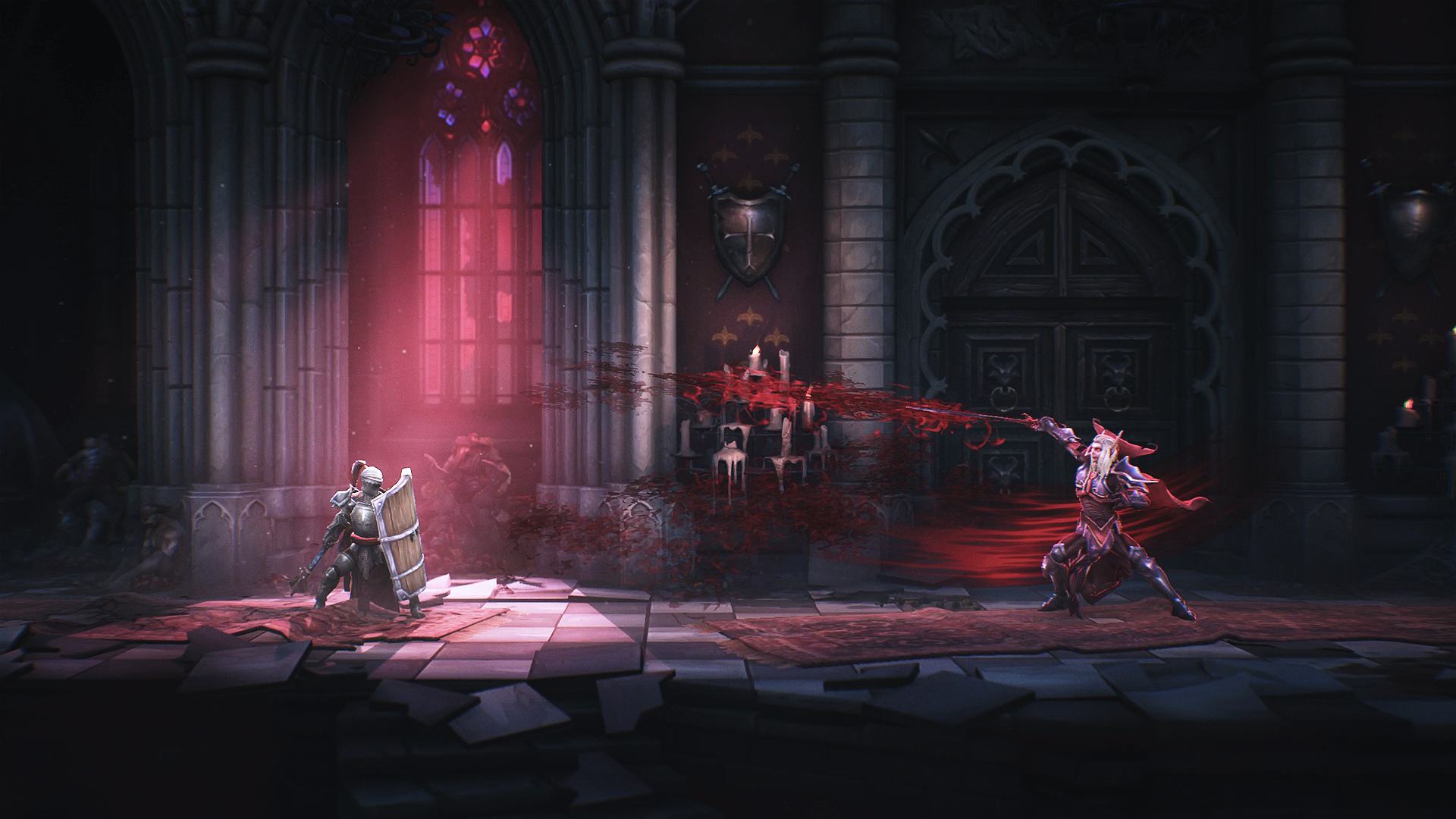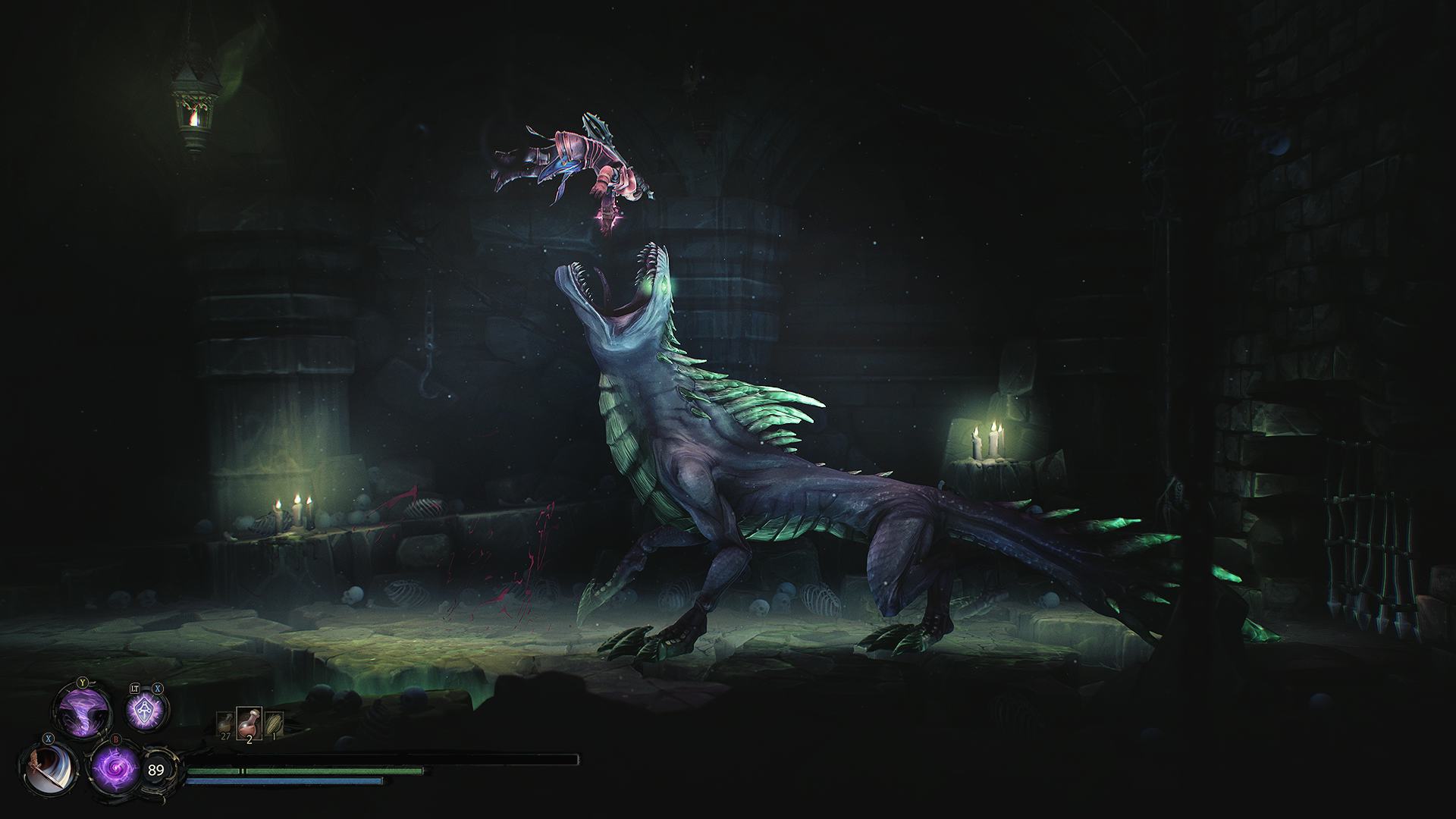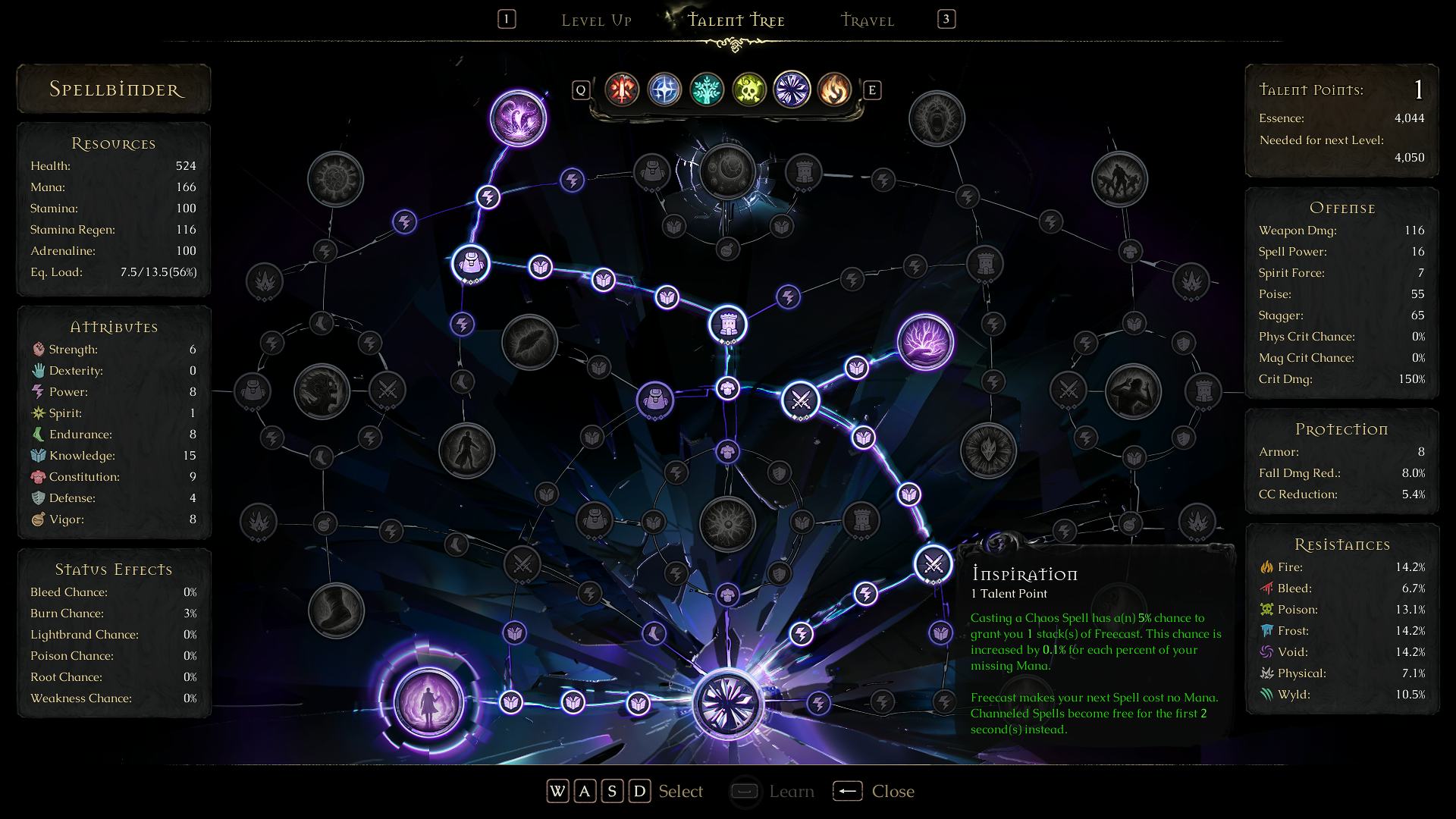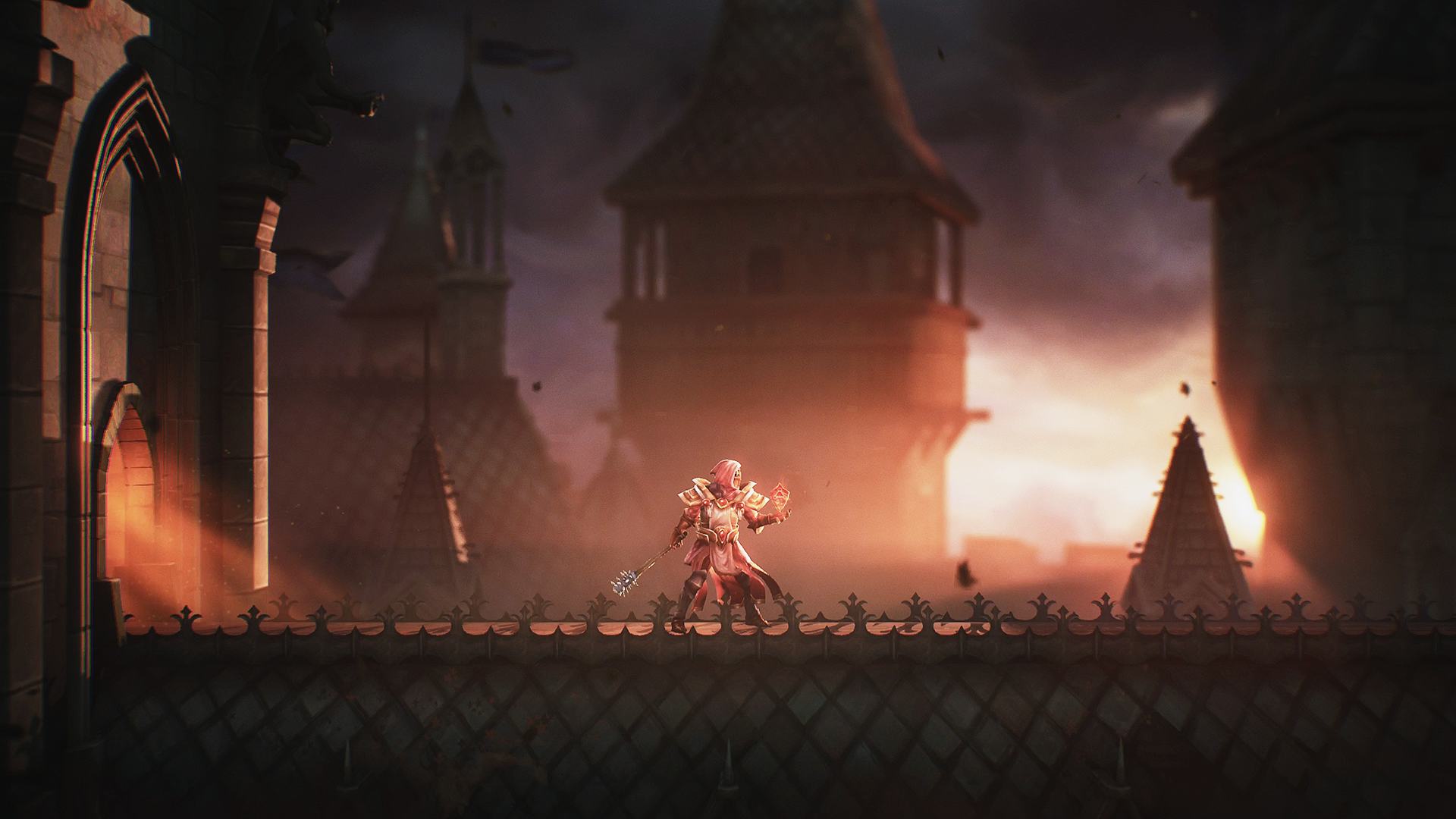
If you want to understand modern action games, looking at Dark Souls and Castlevania: Symphony of the Night will get you much of the way there. More than any other games, these two titles have defined how developers approach level design, character progression, and difficulty in the 21st century. While their outsized influence has led to a lot of uniformity and bad knockoffs, every once in a while a game distills what made them great so well that it almost feels like a breakthrough, even if it’s technically only repeating things we’ve already seen other games do.
Maybe the quickest way to explain the vibe of Mandragora: Whispers of the Witch Tree is, “what if Castlevania hated your guts?” Played from that series’ 2D perspective, Mandragora is also packed full of gothic aesthetics, crumbling castles, and a menagerie of horrifying monsters including some of the most delightfully terrifying vampires games have to offer. To all that, it adds a deep progression system inspired by Dark Souls (and Final Fantasy X, of all things), plus a level of challenge that has me reconsidering my opinions on difficulty in Soulslike games altogether.
Mandragora begins in a dark fantasy world with the Priest King — a man whose resemblance to Skeletor certainly doesn’t foreshadow any villainy on his part — torturing a witch in the great hall of his castle. Your character, one of the king’s Inquisitors, spares the witch in a moment of mercy by ending her life, and is subsequently sent to capture another to take its place, a task which is all but guaranteed to be fatal for you.
Raising the Stakes

So you set off through swamps and sewers, into castles and catacombs, in pursuit of the nefarious witch, slaying hordes of monsters along the way. Mandragora has the look of a Metroidvania, but even if you’re sick of that ubiquitous genre, you may find something to like here. The game’s emphasis is on its brutal combat, and when you find an impassable obstacle, you’ll find a way through or around it by scouring the immediate area for keys and shortcuts more often than not. While you do sometimes need to revisit areas of the map after acquiring new gear that lets you break floors and cross chasms, those powerups come few and far between.
Most Metroidvania games have a certain established rhythm that promotes forward momentum. Most enemies are easy to take down, sometimes without even slowing your pace to do so. More challenging enemies might require trickier timing on a dodge roll or the use of certain limited abilities, but hordes of foes rather than individuals are more likely to pose a threat.
Try playing Mandragora that way and you won’t get far. Every enemy in the game requires some amount of attention and precision. If you don’t bring that to every fight, even the most basic opponents can wipe the floor with you, sending you back to the last checkpoint before you even know what hit you. Any time there are more than two or three enemies on screen, you’re in for a real test of skill and you need to bring everything you’ve got to face it. Mandragora uses an extremely punishing stamina system that only lets you get a few swings in at a time in melee. Overextend yourself and you won’t even be able to dodge to safety after executing a combo.

Then you reach one of Mandragora’s real skill check bosses and everything before it seems easy. Some of Mandragora’s bosses are close to pushovers, able to be taken down in just a few tries if you’ve got good reflexes for dodging and instincts on how to use your abilities. Many of these bosses repeat throughout the game with minor twists to their move sets, giving you a chance to hone your approach to them to perfection. Others, what you might consider the game’s main bosses, demand much more of you. Mandragora’s boss design is almost always excellent, with each new boss bringing a fresh suite of skills to battle. Many spawn additional enemies, some revive themselves for a second round when you think you’ve won and others change the arena as you fight. All of them hit like a truck.
I hated all of Mandragora’s best bosses at first. I came embarrassingly close to flinging my controller in frustration as I fell to them again and again. I yelled “This is bullsh*t!” so much I’m now worried about what my neighbors think of me. But I learned.
That unblockable grab can be avoided by standing in just the right spot. That floor-sweeping attack that roots you in place can actually be outrun. It’s not just important but crucial to learn bosses’ patterns and find tricks to mitigate their strongest attacks, so much so that Mandragora’s toughest fights verge on becoming puzzles. Bosses often do so much damage that there’s simply no time to learn how to fight them on your first few tries, but that critique aside, I’ve come to love the way extreme friction in Mandragora can be overcome not through sheer power, but through careful observation and experimentation. The same is true of difficult spots outside of boss battles. By drawing out certain enemies or using level design to your advantage, you can often overcome overwhelming odds by outsmarting enemies rather than plowing through them.
No Pain, No Gain

Mandragora’s difficulty — and the whole experience of playing it — can also change immensely based on how you build your character. At the start, you’re offered six classes, and a handy onscreen guide shows how well they fare in areas like melee and ranged combat, mobility, and defense. I went with the Vindicator, a defense-focused caster that wields a one-handed mace while flinging offensive spells that also grant damage absorption and health regeneration. Whichever class you choose, you’ll get a unique passive ability, plus access to a sprawling talent tree that resembles Final Fantasy X’s Sphere Grid.
Like Mandragora’s combat, its talent trees at first seem overwhelmingly complicated, but I’ve grown to love them as I play. Talent trees comprise multiple branches of nodes, each representing a stat upgrade or new passive skill. Every time you level up, you can unlock the next node along any of these paths, slowly working along the tree’s tendrils to reach better upgrades. You’re first locked to your own class tree, but after level 15, you can start learning talents from others — though that’s not recommended unless you really know what you’re doing. If there’s an overpowered build that makes Mandragora easy I haven’t found it. I’ve enjoyed plotting out my path through the talent tree, but almost every time I’ve unlocked a new passive skill it’s felt impactful enough to change and deepen the way I play.
A Dark And Stormy Night

Mandragora’s story doesn’t quite match its mechanical depth, but I was still pleasantly surprised by parts of it. Yes, you can guess the “twist” that the tyrannical Priest King is more dangerous than the witches you’re hunting within a millisecond of meeting him, but things get much more interesting once your Inquisitor turns against their former boss. The state affairs of this dark fantasy world are enjoyable to explore despite not being groundbreaking, and they set the game’s grim tone well. Mandragora’s fantastic art style also does a lot of work in setting the tone, building an intensely dark world where beauty — in sunsets, soaring architecture, and lovingly rendered characters — occasionally shines through. Its monster designs are frightening and original but not grotesque, and their excellent animations help keep combat feeling dynamic as well as readable, so you’re unlikely to lose a fight out of sheer confusion.
What surprised me most about Mandragora is how funny it often is. One of my favorite moments of the game involves the choice to free a vampire who’s been trapped and starving for years, with immediate, hilarious consequences. You’ll recruit companions to hang out with you near a spooky cursed tree that grants you powers, and their interactions crack the game’s foreboding facade with some added levity that doesn’t break the fourth wall or descend into trite quippiness.
It would be easy to let Mandragora fade into the crowd of Soulslike Metroidvanias, but it’s so much more than the sum of its parts. I’ve avoided a lot of Soulslike games over the years for what felt to me like focusing on difficulty to the exclusion of all else. But while Mandragora can be extremely punishing, it’s a reminder that difficulty can also be an expression of a game’s world, and pushing through that challenge can be far more satisfying than completing a game that doesn’t take such pleasure in pushing players to their limits. Mandragora is one of the most nerve-wracking games I’ve played in years, and I’m already eager to pick up another of its classes and wallow in its infuriating joy all over again.
8/10
Mandragora: Whisper of the Witch Tree launches on April 17 on PlayStation 5, Nintendo Switch, Xbox Series X/S, and PC. Inverse was provided with a PC copy for this review.
INVERSE VIDEO GAME REVIEW ETHOS: Every Inverse video game review answers two questions: Is this game worth your time? Are you getting what you pay for? We have no tolerance for endless fetch quests, clunky mechanics, or bugs that dilute the experience. We care deeply about a game’s design, world-building, character arcs, and storytelling come together. Inverse will never punch down, but we aren’t afraid to punch up. We love magic and science-fiction in equal measure, and as much as we love experiencing rich stories and worlds through games, we won’t ignore the real-world context in which those games are made.







